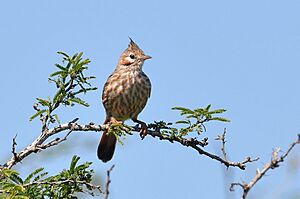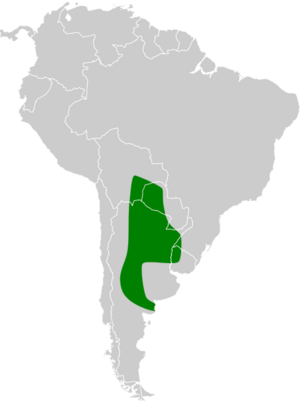Lark-like brushrunner facts for kids
Quick facts for kids Lark-like brushrunner |
|
|---|---|
 |
|
| Conservation status | |
| Scientific classification | |
| Genus: |
Coryphistera
|
| Species: |
alaudina
|
 |
|
The lark-like brushrunner (Coryphistera alaudina) is a cool bird from the ovenbird family called Furnariidae. It lives in South America, in countries like Argentina, Bolivia, Brazil, Paraguay, and Uruguay. This bird is special because it looks a bit like a lark, even though it's not related to them!
Contents
About the Lark-like Brushrunner
This bird is part of the ovenbird family, called Furnariidae. It's most closely related to another bird called the firewood-gatherer. The lark-like brushrunner is the only species in its group, called Coryphistera. There are two types, or subspecies, of this bird: C. a. alaudina and C. a. campicola.
What Does It Look Like?
The lark-like brushrunner is a medium-sized bird, about 15 to 17 cm (5.9 to 6.7 in) long. It weighs between 27 to 42 g (0.95 to 1.5 oz), which is about the same as a few quarters. Both male and female birds look the same. They have a cool crest on their head that stands up.
Around their eyes, they have white feathers that go back to their ears. Their forehead is brownish, and their crest is very dark brown. Their back is light brown with darker stripes. Their wings are dark brown, and their tail feathers are mostly reddish-brown.
Their chin and throat are whitish. Their chest is whitish with blurry reddish stripes. These stripes become browner on their belly and sides. Young birds have a shorter crest and less clear stripes than adult birds.
Where Does It Live?
The lark-like brushrunner lives in South America. The C. a. alaudina subspecies is found in southern Bolivia, northern and eastern Argentina, and parts of Uruguay and Brazil. The C. a. campicola subspecies lives in southeastern Bolivia and western Paraguay.
These birds like open or partly open areas. They live in dry scrublands, woodlands, savannas, and even pastures with trees. Sometimes, they can be found in farm fields. They live from sea level up to about 500 m (1,600 ft) high.
Behavior and Life
Movement
Most lark-like brushrunners stay in the same area all year long. However, some birds from the southernmost parts of their range might fly north during the winter.
Feeding Habits
The lark-like brushrunner mainly eats arthropods, which are insects and spiders. They also eat snails. During the time they are raising their young, they hunt for food in groups of up to seven birds. When it's not breeding season, these groups can be as large as 15 birds. They also join other bird species to find food.
These birds mostly look for food on the ground. They walk along, picking up prey. They also scratch the ground or turn over animal droppings to find hidden food.
Reproduction and Nesting
Lark-like brushrunners usually have their babies in the spring and summer, from September to January. They are thought to stay with one partner. However, sometimes groups of birds are seen together that might not be just a family, which makes scientists wonder.
They build a large, round nest using thorny sticks and branches. These nests can be as big as 100 cm (39 in) across! Inside, there's a tunnel that leads to a cozy room lined with grass and feathers. Sometimes, they even decorate the tunnel with colorful things like butterfly cocoons or bits of colored glass. They usually place their nests on tree branches, about 2 and 5 m (7 and 16 ft) above the ground.
A female bird usually lays three or four eggs, but sometimes five. Scientists don't know exactly how long the eggs take to hatch or when the baby birds leave the nest.
Bird Calls
The song of the lark-like brushrunner sounds like a high-pitched, shaky, tinkling trill. It might sound like "rrrrrew" or "croe, criiii". They also make other sounds, like low buzzing trills and squeaky notes.
Conservation Status
The IUCN (International Union for Conservation of Nature) says the lark-like brushrunner is a species of "Least Concern." This means they are not currently in danger of disappearing. They live across a very large area, and their population seems to be stable. There are no immediate threats to these birds. They are quite common in many places where they live and are found in several protected areas.


